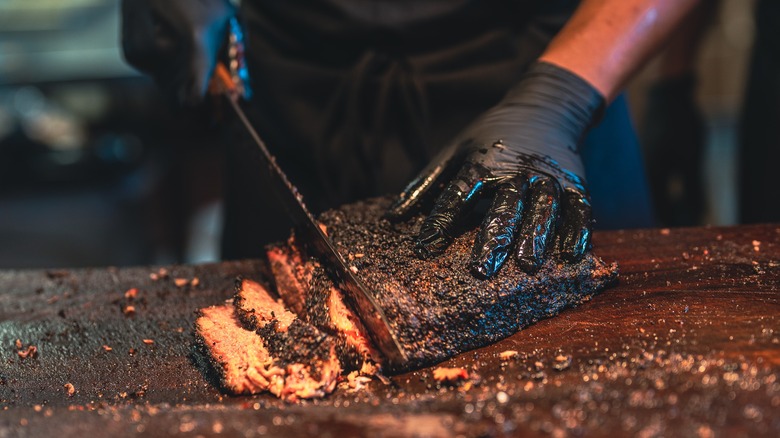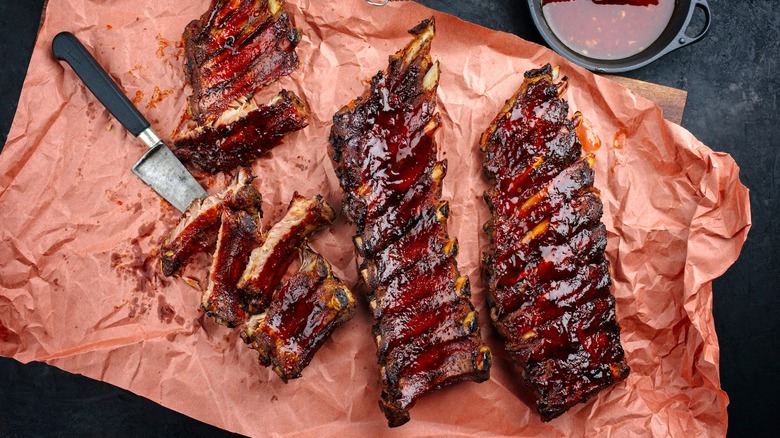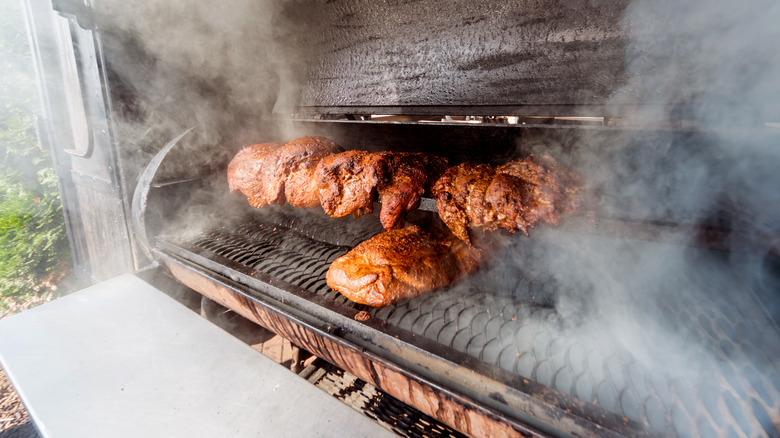Don't Wrap Meat In Foil If You're Looking For A Smoky Bite
It happens to experienced pitmasters as well as to backyard barbecue devotees: the dreaded "stall," where a piece of meat being lovingly tended over gentle heat simply ... stops heating, usually around 150 or 170 degrees Fahrenheit, even as it continues to sit in a warm smoker. There are theories as to why this happens, relating to factors like moisture evaporation off the surface of the meat. But the bottom line is that it can be an annoying and time-consuming part of what's already a long process. Sometimes a piece of meat will stall for hours before its temperature starts rising again.
To combat the stall, some pitmasters wrap their meat partway through cooking. What to cover it with? Many use aluminum foil, but it isn't the best solution. As an air-tight barrier, foil keeps the smoke from getting to your meat. And, while you want to keep things juicy, foil prevents moisture from escaping altogether, which can make the meat soggy — and the crust not nearly as crunchy as it could be. There's a better option: butcher paper, relied upon by 'cue mavens including Aaron Franklin, proprietor of the beloved Austin restaurant Franklin Barbecue. This breathable paper lets smoke penetrate the meat while it climbs to the right temp — ensuring you those seductively complex flavors that are, of course, the whole reason you're going through the trouble of smoking in the first place.
What is butcher paper, anyway?
Butcher paper a type of extra-strong food-safe kraft paper that's sold in rolls; as its name suggests, it's used by butchers and fishmongers to wrap their products. But butcher paper — particularly pink butcher paper — is also a favorite tool of pitmasters (and shouldn't be confused with parchment or wax paper, neither of which are barbecue-appropriate). Its strength means that it can hold up to the rigors of the cooking process without tearing, and its relative porousness, compared to air-tight foil, means that smoke can continue to perfume the meat without a whole lot of moisture loss.
That's important because, of course, "low and slow" is the name of the game. Beyond imparting that deliciously smoky flavor, what you're doing here is cooking your 'cue for such a long time that it's not only reaching the "done" stage but going far beyond it — until the collagen in the flesh breaks down into gelatin, yielding ultra-tender, ultra-juicy brisket, ribs, pork butt, and more. Hence the delicate balance: You need the meat to cook for a long time and reach those higher temps — smoked brisket, for instance, is best around 200 degrees Fahrenheit, whereas something like a steak is considered safely cooked at 145 degrees. But you also don't want it to dry out. That's where the wrapping comes in.
How to use butcher paper for a smokier taste
There's a reason people use foil: It's convenient. But it's not going to give you the very best barbecue you can achieve at home. Foil blocks smoke and, by trapping moisture, prevents the formation of that famous "bark," the irresistibly craggy and salty crust that materializes on well-barbecued meat. Luckily, butcher paper is just as easy to use. When whatever you're smoking gets to the stall phase, it's time to wrap it up. Slice off a piece big enough to envelop your meat, and consider double-wrapping if you're dealing with an extra-large cut. Fold or roll the paper at the edges to seal in the meat, then throw it back on the smoker until it reaches the target temp.
In a YouTube video, Aaron Franklin tried smoking brisket in butcher paper, in foil, and "naked," with no wrapping at all. In truth, each outcome looked and no doubt tasted spectacular — this is one of America's best pitmasters. But Franklin detected differences. The foil-wrapped brisket came out "a little more pot-roast-y," he said, which sounds great if pot roast is what you're after. The naked brisket was crunchier around the edges. The brisket wrapped in butcher paper? "Right in the middle," Franklin noted — not too dry but not completely falling apart, smoke-kissed, and perfectly succulent. In other words, the Goldilocks zone. Now comes the hard part: picking a barbecue sauce.


